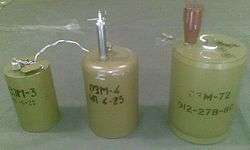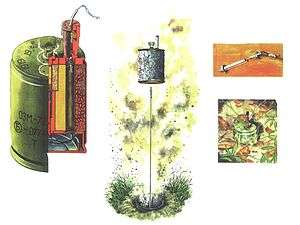OZM




The OZM-3, OZM-4 and OZM-72 are Soviet manufactured bounding mine type anti-personnel mines.
They are normally painted olive green, and issued with a spool of tripwires and two green painted wooden or metal stakes for affixing the tripwires. Both OZM-3 and OZM-4 have cast iron fragmenting bodies while the OZM-72 also contains preformed steel fragments, and all three are issued with empty fuze wells, so a variety of fuzing options are possible.
Operation
The mines can be activated by a variety of fuzes, including electronic fuzes or command initiation, although they are most commonly fitted with an MUV booby trap switch which is activated by a tripwire.
On firing, a metal base plate remains in the ground, while the mine body is thrown up by a small lifting charge, but remains attached to a strong wire tether. When the end of the tether is reached at a height of approximately 0.5 m, the main charge explodes and scatters fragments of the casing across a wide area.
OZM mines may sometimes be laid directly on top of a PMN-MC3 device. The PMN-MC3 is an anti-handling device which closely resembles a PMN mine, except that it has a "blister" on top and operates purely as a pressure-release boobytrap. Lifting an OZM mine (without rendering safe the PMN-MC3 placed underneath) will trigger detonation.
Variants
OZM-3
- Diameter: 7.6 cm
- Height: 13 cm
- weight: 3.2 kg
- Fragmentation c TNT
OZM-4
| Casing material | cast iron |
| Weight | 5.4 kg |
| Fragmentation charge (TNT) | 170 gr |
| Casing diameter | 90 mm |
| Casing height | 170 mm |
| Length of the sensor target (one-way) | 13 meters |
| Sensor sensitivity | 1–17 kg |
| Radius of guaranteed lethal destruction | 13 meters |
| Temperature usage range | -60 to +60 Degrees Celsius |
OZM-72
| Casing material | iron |
| Weight | 5 kg |
| Fragmentation charge (TNT) | 660 gr |
| Casing diameter | 108 mm |
| Casing height | 172 mm |
| Sensor sensitivity | 1–17 kg |
| Radius of guaranteed lethal destruction | 25 meters |
| Temperature usage range | -60 to +70 Degrees Celsius |
| Number of preformed steel fragments | 2400 pcs. |
Ottawa Treaty
Since the Ottawa Treaty, a number of countries have decided to retain their OZM mines, but convert them to command detonation only by destroying all fuzes which can be indiscriminately activated – potentially by non-combatants or animals. Belarus in particular has decided to keep 200,000 OZM-72.
See also
| Wikimedia Commons has media related to OZM. |